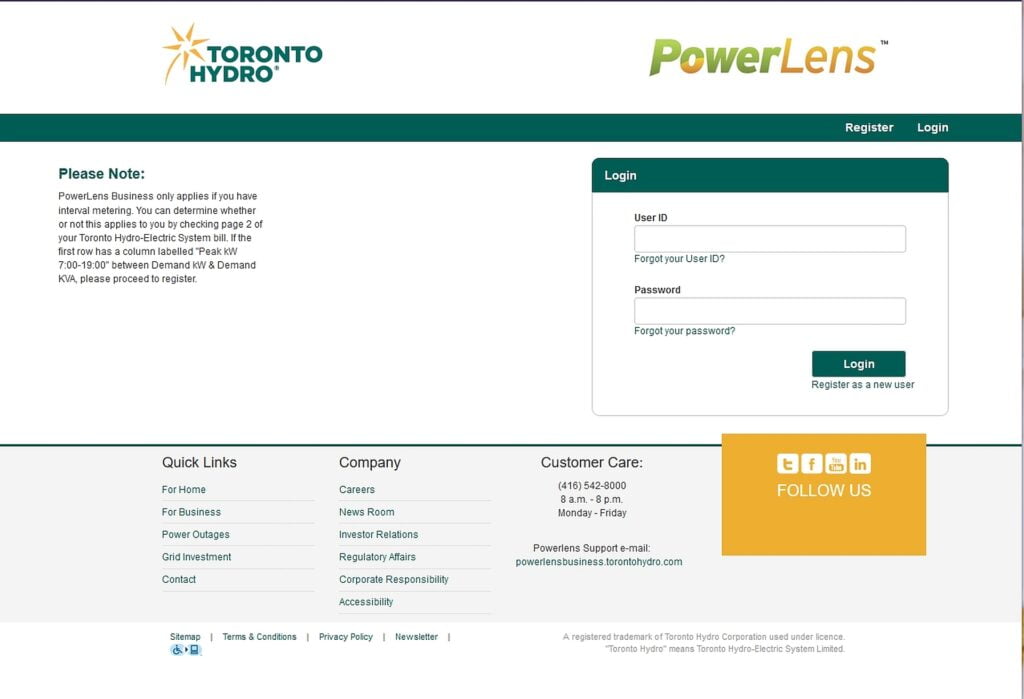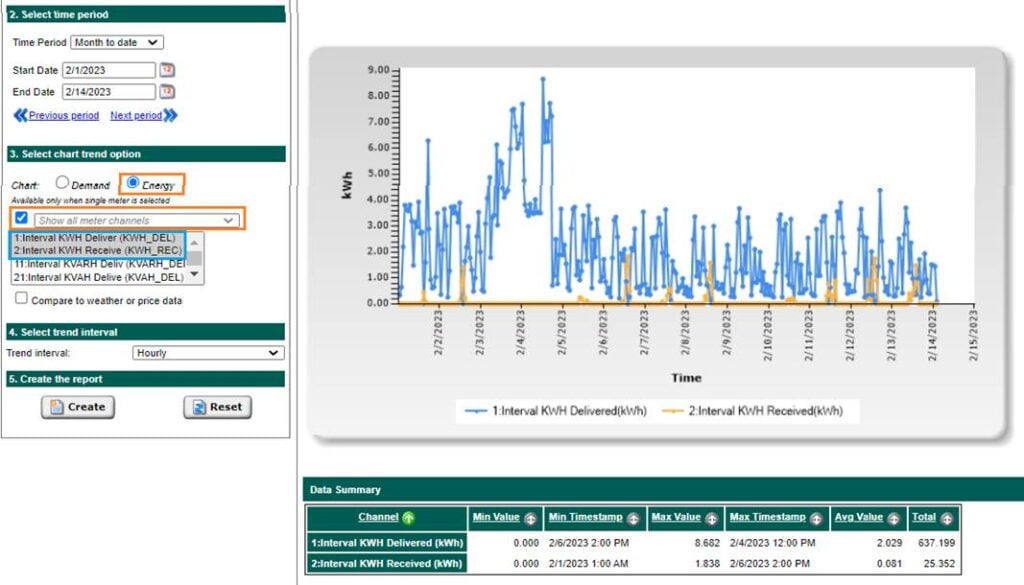PowerLens: Toronto Hydro’s web portal for customers who generate power. That’s you with the solar panels. Solar panels generate energy to power your home and maybe net you credits. Through Ontario’s net metering program, the solar inverter sends any excess energy your home doesn’t consume to the hydro grid.
PowerLens also tracks consumption data, the kind you’re used to seeing in Toronto Hydro’s residential customer portal. But once you sign a solar connection agreement with Toronto Hydro and/or one for house batteries and get your solar panels installed, you will have your hydro meter switched out for a bidirectional meter.
A regular residential meter reads all electricity running through it as power you’ve used. That includes solar power. The bidirectional meter can distinguish between solar power and hydro grid power. It reads electricity running through it from your solar panels as credits and electricity running from the grid to your house through it as billable. You’ll receive no credits until Toronto Hydro switches out your regular meter for the hulk of a bidirectional meter (ensure it’s placed higher than the tallest person, otherwise bonk).
Your New Web Portal
Along with the bidirectional meter, Toronto Hydro finalizes your residential bill, restarts your billing under the same account number (just to confuse you), and moves you onto PowerLens, their business web portal for solar generation and hydro grid consumption.
I know, I know. You’re not a business. Neither am I. It makes no sense. Why can’t we stay in the familiar residential customer portal?!! Well, solar panels generate power, and the only ones who generate power in Toronto Hydro’s historical purview are businesses. Bonkers, I know. But we’re stuck with it for now.
Call your Councillor and complain to Toronto Hydro to have residential solar customers stay on the residential portal!
How Do You Get On PowerLens?
When you go to login to your usual portal, it will tell you that you’re now on PowerLens. Don’t bother signing up by yourself. Call Toronto Hydro, and the friendly customer support team will step you through the registration process while you’re on the phone with them. The better you are at keeping your frustration in check, the quicker and better service you’ll receive. Remember the adage: honey catches more flies!

Once you’re registered and learn how to login, subsequent logins may erratically bork. Your memory hasn’t dropped into the abyss…unless you’ve confused your Toronto Hydro email user name with your PowerLens user name. If there’s a problem, try another day. The same, by the way, is true for generating reports. Occasionally, PowerLens won’t generate a report. You know it’s a bug when you see the graph line end abruptly in the wee hours on the chart (see below). They usually fix it within hours or a day. If not, call Toronto Hydro.
Using PowerLens
PowerLens is best used on your desktop.
The website is designed for large desktop displays. You can use it on your tablet, but it won’t be as easy to see nor will you be able to download reports easily or at all.
Once logged in, you’ll be met by three choices.
Click on View Usage.
You’ll now see four choices, none of which seem to correspond to what you’re used to on the residential customer portal. Click on Check Interval Data Now. Yeah, not usage, interval data.
The screen that greets you is designed for HVAC engineers, not you and me. But never mind.
At this point, you can try to generate a report. But it may be a month after your bidirectional meter install before you’ll be able to. It takes awhile for the data to appear, though this could be different for you than it was for me.
On the left side of the screen, you’ll see numbered sections under Settings. Hopefully, your account should be automatically entered and selected. If you don’t see a meter number whose first date is the day you received your bidirectional meter, call Toronto Hydro.
Go to number 2 and choose your date range. It’s in the form of month/day/year. Not logical but what can you do.
Now under option 3. Select chart trend options:
- Select Energy.
- Click on the box next to Compare to other meter channels (let the page re-fresh) (If you’re seeing Reactive, then you’ve selected the wrong option)
- From the drop-down arrow next to Compare to other meter channels, select Show all Meter Channels (let the page re-fresh)
- Hold the Shift key on your keyboard and select 1. Interval KHW Deliver (KHW_DEL) and 2. Interval KHW Received (KHW_REC)
- When done, click on Create at the bottom of the screen to run the report.

At this point during my first tries, even though the report ran, producing a chart showing consumption (delivered) in blue and generation (received) in red on my screen, I was unable to download reports. I also had trouble remembering how to generate reports — that’s why Toronto Hydro took my feedback and are/have created an instruction page with screenshots to aid newbies.
Toronto Hydro created automatic reports for me to be delivered to my inbox daily and, as well, a monthly usage one. I initially wanted hourly intervals like what you see on the residential customer portal, but hourly lead to confusion — some time periods didn’t make sense. I discovered drilling down to 15-minute intervals cleared things up.
Fifteen or five-minute intervals in an hour block lets you see what’s going on with consumption and generation in one hour for each hour of the day and night. Sometimes, during one or two 15-minute intervals in a midday hour block, you’ll consume no hydro from the grid and/or have no solar power credits. Unlike the hourly interval chart, the 15-minute interval chart helps you understand how the net metering program works and how your solar power generation is doing.
Billing
A couple of notes.
- Under the tiered rate, the monthly limits are not actually calculated per month. Instead, limits are calculated per day. That’s why in some months, you’ll be charged the higher rate before you reach the 1000 kWh winter limit for the lowest rate.
- Consumption and generation are not added together. Each is billed/credited separately. So, for the tiered rate, you’ll be billed the lowest rate for the first 1000 kWh (in winter); and you’ll be credited on a separate track for the first 1000 kWh solar energy sent to the grid. Despite this, the tiered rate netted me a lower bill in winter than time-of-use.
- Although you can switch to time-of-use during the summer so that your credits can achieve the maximum rate during the day then back to tiered in winter, you don’t have access to the handy calculator on the Toronto Hydro customer portal to figure out when or if to do so. Since your usage data is on PowerLens, the residential portal has no access to it. (Again, complain to your Councillor.)
Compare Tiered and Time-of-Use: Not Easy
Use Ontario Energy Board’s (OEB) rate calculator to compare rate plans for your energy usage. Their calculator takes more time because you have to enter information that Toronto Hydro’s portal already has, but apparently, it’s more robust. Well, under Residential, I see no solar credit option. You choose your utility then input Total Usage or Price Periods. I used Total Usage for consumption calculation cost.
You can either check your latest bill for your total usage in kWh or you can run a report in PowerLens for the latest full month and use the amount from the table’s first row labelled “1: Interval KWH Delivered (kWh).” For me, tiered still nets me a lower consumption bill.
To figure out solar: from the table’s second row labelled “2: Interval KWH Received (kWh),” take the total amount. Use Price Periods instead of Total Usage on the Ontario Energy Board’s calculator and enter the total in the TOU On-peak field since solar is only during the day. It’s true that during the summer, some of it will be mid-peak pricing and some on-peak pricing, but I think most of the credits will come during on-peak. It would be easier if this calculator included solar credits!
If I input the solar kWh as Total Usage, the difference between tiered and time-of-use is minimal. If I input solar as TOU On-Peak, the difference is noticeable. It would probably be even moreso if I could figure out how to parse the consumption kWh across time periods since I consume more at the beginning and ending of the day than in the middle when solar is 100% powering my home. But…
…the other problem is that solar doesn’t have delivery and regulatory charges attached to it as far as I know, yet the OEB’s rate calculator will add that on to their results. At this point, calling Toronto Hydro and having a talk with one of their billing specialists will probably give you the best picture of what will provide you with the lowest bill.
I Prefer Tiered
Tiered is easy to follow. And since I rarely use more than 1000 kWh, even this past winter when I’d gotten rid of natural gas and my heat pump was heating my home, tiered netted me a lower bill than time-of-use. But then I’ve been conserving energy for years and years. It’s amazing how much less energy you use when you turn off the lights or turn off the computer at night and use LEDs and buy EnergyStar goods when you have to replace old things.
Having solar power means I no longer pull much energy from the grid during the day. The reason they charge the highest rate under time-of-use for energy used during the day is that’s when they have their biggest draw. They want to preserve the reliability of the grid and avoid power outages from too big a draw. But people with disabilities cannot have their homemakers, therapists, and caregivers come in the middle of the night when rates are at their lowest. Time of use is not inclusive at all. Tiered rate, while conserving energy, is.
Billing Issues
You will in all likelihood have billing issues when you add solar power. Prepare to spend months trying to receive your new bill and/or understand your new bill and resolve miscalculations. If you don’t fix things right away like, for example, doubled Ontario Electricity Support Program credits or not seeing any bills, the amount you’ll owe when it’s finally fixed or arrived will suck the breath out of you. Toronto Hydro will provide a monthly repayment plan, though. If they don’t offer it, ask for it. Remember honey catches more flies — polite persistence will net you quicker, better service. Do your yelling at the furniture!




